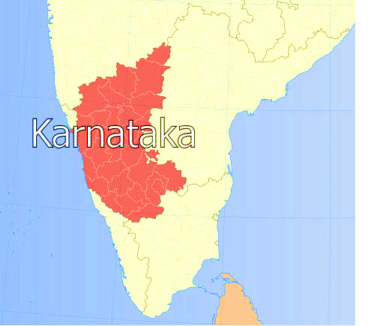ಕನ್ನಡ

(Bildquelle: PlaneMad/Wikipedia. -- CC-by-sa)
An Elementary Grammar of the Kannada, or
Canarese Language
by Thomas Hodson
36.
Syntax of Adverbs (§§ 304 - 318)
Zitierweise / cite as:
Hodson, Thomas: An elementary grammar of the
Kannada, or Canarese language. -- 36.
Syntax of Adverbs (§§ 304 - 318). -- Fassung vom 2011-08-27. -- URL:
http://www.payer.de/hodson/hodson36.htm
First published as: Hodson,
Thomas: An elementary grammar of the Kannada, or Canarese language ; in
which every word used in the examples is translated, and the pronunciation is
given in English characters. -- 2. ed. -- Bangalore : Wesleyan Mission Press,
1864. -- 128 p. ; 23 cm.
First time published here:
2011-08-27
Revisions:
©opyright: Public domain
This text is part of the section
Sanskrit und Indien of
Tüpfli's Global Village Library
If you don't get the
diacritics displayed, install a Unicode font like Tahoma.
Syntax [ಪ್ರಯೋಗ prayōga]
of Adverbs [ವಿಶೇಷಣ viśēṣaṇa]
0. Contents
- 1. ಆಗ āga, ಈಗ īga
- 2. ಅಂತೆ aṃte, ಹಾಗೆ hāge,
ಪ್ರಕಾರ prakāra, ಅಪ್ಪಂದ appaṃda, &c.
- 3. ಅಲ್ಲದೆ allade
- 4. ಅಂತ aṃta, and
ಇಂತ iṃta
- 5. ಬಹಳ bahaḷa,
Much
- 6. ಆಗಿ āgi
304. Adverbs may be formed to an almost unlimited extent by
adding ಆಗಿ āgi, to nouns and adjectives (See
§ 130.)
305. The declinable adverbs (See
§§ 131 - 138,) are in many
respects treated like nouns and adjectives; as,
- ಮುಂಜಾನೆ ಹೋಯಿತು muṃjāne hōyitu, The
first watch is past.
- ನಿನ್ನಿನ ಕೆಲಸ ninnina kelasa,
Yesterday's business.
- ಅಲ್ಲಿಯ ಜನರು alliya janaru, The
people of that place.
- ನೀವು ಎಲ್ಲಿಯವರು nīvu elliyavaru, Of
what place are you?
- ಈಗಿನ ಕಾಲ īgina kāla, The present
time.
306. Most adverbs precede the words affected by them; and
these words may be nouns, adjectives, verbs, participles, gerunds or other
adverbs; as,
- ಶಾನೆ ನೀರು śāne nīru, Much water.
- ಬಹು ಚಿಕ್ಕ ಮನೆ bahu cikka mane, A
very little house.
- ಚನ್ನಾಗಿ ಓದುತ್ತಾನೆ cannāgi ōduttāne,
He reads well.
- ಬೇಗ ನಡೆಯುವ ಎತ್ತು bēga naḍeyuva
ettu, A fast walking ox.
- ಅವನಿಗೆ ಬೆಳಿಗ್ಯೆ ಹೋಗಿ ತಿಳಿಸು
avanige beḷigye hōgi tiḷisu, Go in the morning and inform him.
- ಬಹು ಜಾಗ್ರತೆಯಾಗಿ ತಕ್ಕೊಂದು ಹೋದರು
bahu jāgrateyāgi takkoṃḍu hōdaru, They carried it away very carefully
1. ಆಗ āga, ಈಗ īga
307. ಆಗ āga, and ಈಗ īga, regarded as adverbs of time, stand alone at
the commencement of a sentence or part of a sentence; as,
- ಆಗ ಅವರೆಲ್ಲರು ಅತ್ತರು āga avarellaru attaru, Then they all wept.
308. ಆಗ āga, is affixed to relative participles; as,
- ನಾವು ಹೋಗುವಾಗ nāvu hōguvāga, When we go.
- ಅವರು ಒಳಗೆ ಪ್ರವೆಶಿಸಿದಾಗ avaru oḷage praveśisidāga, When they entered in.
- ಕೆರೆಯಲ್ಲಿ ಈಜುತ್ತಿರುವಾಗ kereyalli ījuttiruvāga, Whilst swimming in the tank.
- ನಾನು ಹೊರಟು ಹೋಗಿದ್ದಾಗ nānu horaṭu hōgiddāga, When I had gone out.
309. āga, takes the demonstrative and interrogative particles;
as,
- ಆವಾಗ āvāga, Then
- ಈವಾಗ īvāga, Now.
- ಯಾವಾಗ yāvāga, When?
- ಯಾವಾಗಲೂ yāvāgalū, Always.
2. ಅಂತೆ aṃte, ಹಾಗೆ hāge,
ಪ್ರಕಾರ prakāra, ಅಪ್ಪಂದ appaṃda, &c.
310. ಅಂತೆ aṃte, ಹಾಗೆ hāge,
ಪ್ರಕಾರ prakāra, ಅಪ್ಪಂದ appaṃda, &c. &c., when affixed to
the genitive case, signify like, as; as,
- ಅದರಂತೆ ಇದು adaraṃte idu, That is like that.
- ನಿಮ್ಮ ಹಾಗೆ ನಾವು nimma hāge nāvu, We are like you.
- &c. &c.
311. The same words affixed to relative participles, signify
so that, in order to, &c.; as,
- ತನ್ನ ಸಾಮರ್ಥ್ಯ ತೋರಿಸುವ
ಹಾಗೆ ಆಡಿದನು tanna sāmarthya tōrisuva hāge āḍidanu, He acted to
display his ability.
- ಬಂದಂತೆ ಹೋಯಿತು baṃdaṃte hōyitu, It went as it came.
- ಯಾರಿಗೂ ತಿಳಿಯದ ಹಾಗೆ
ಮಾಡಿದನು yārigū tiḷiyada hāge māḍidanu, He did so that no one
might know.
3. ಅಲ್ಲದೆ allade,
Besides, except, &c.
312. ಅಲ್ಲದೆ allade, besides, except, &c. is used after nouns; as,
- ಅವನು ಹಣಗಾರನಲ್ಲದೆ
ಧರ್ಮಿಷ್ಠನಾಗಿದ್ಧಾನೆ avanu haṇagāranallade dharmiṣṭhanāgiddhāne, He is a
liberal man as well as being rich.
- ಇದು ಗಜವಲ್ಲದೆ ಅಜವೋ idu gajavallade ajavō, Is this a goat and not an elephant?
313. ಅಲ್ಲದೆ allade, is used with pronouns and verbal nouns; as,
- ನೀವಲ್ಲದೆ ಇಂಯಾರು ದೊಡ್ಡವರು nīvallade iṃyāru doḍḍavaru, Who are great people except yourselves (or,
if you are not)?
- ತಾನು ಹೋಗುವದಲ್ಲದೆ ಮಗನನ್ನು ಕರ
ಕೊಂಡು ಹೋಗುತ್ತಾನೆ tānu hōguvadallade maganannu kara koṃḍu hōguttāne,
He will not anly go himself, but take his son with him.
- ಅವನು ಹುಶಿ ಆಡಿದ್ದಲ್ಲದೆ
ನನ್ನನ್ನು ಬೈದನು avanu huśi āḍiddallade nannannu baidanu, He not only
told a lie, but abused me.
314. It is used after the different moods,
tenses and persons of verbs; as,
- ನೀನು ಹೀಗೆ ಹೇಳುತ್ತೀ ಅಲ್ಲದೆ
ನನಗೆ ಸಹಾಜ ಮಾಡುವದಿಲ್ಲ nīnu hīge hēḷuttī allade nanage sahāya
māḍuvadilla, You not only speak thus, but refuse to help me. Or, You only
say so, and do not assist me.
- ಎಲ್ಲರು ಮಾತು ಕೊಟ್ಟರಲ್ಲದೆ
ಒಬ್ಬರೂ ಏನೂ ಮಾಡಲಿಲ್ಲ ellaru mātu koṭṭarallade obbarū ēnū māḍalilla,
Everybody promised, but nobody did anything.
- ನಾವು ಹೋಗುವೆವಲ್ಲದೆ ಮಾಡುವದೇನು
nāvu hōguvevallade māḍuvadēnu, We shall (may) go, but what can we do?
4. ಅಂತ aṃta, and
ಇಂತ iṃta
315. ಅಂತ aṃta, and
ಇಂತ iṃta, are affixed to nouns and pronouns with which
anything is compared; as,
- ಕುದುರೆಗಿಂತ ಕುರಿ ಚಿಕ್ಕದು
kuduregiṃta kuri cikkadu, A sheep is less than a horse.
316. In comparing time ಮುಂಚೆ
muṃce, &c. are added also; as,
- ನಾನು ಹೇಳುವದಕ್ಕಿಂತ ಮುಂಚೆ
ಕೊಟ್ಟನು nānu hēḷuvadakkiṃta muṃce koṭṭanu, He gave before I asked.
5. ಬಹಳ bahaḷa,
Much
317. ಬಹಳ bahaḷa, much, is
used forming comparisons; as,
- ನನಗಿಂತ ಅವನೀ ಬಹಳ ದೊಡ್ಡ
ವಿದ್ವಾಂಸನು nanagiṃta avanī bahaḷa doḍḍa vidvāṃsanu, He is a much more
learned man than I.
6. ಆಗಿ āgi
318. Many pure adverbs admit the affix
ಆಗಿ āgi; as,
| ನುಣ್ಣಗೆ
nuṇṇage |
ನುಣ್ಣಗಾಗಿ
nuṇṇagāgi |
smoothly |
To 37. Syntax of Postpositions (§§ 319 - 320)

